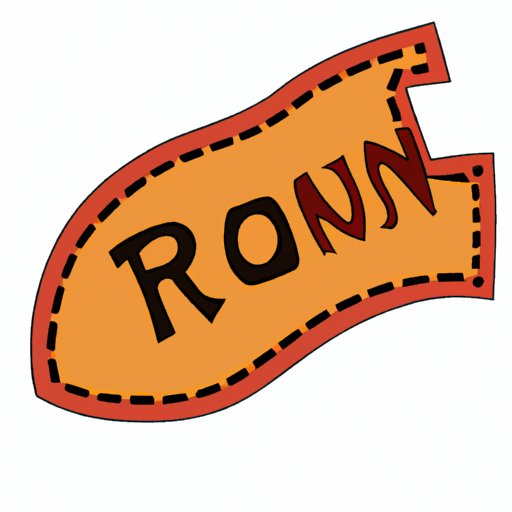Introduction
If you’re looking to add a little personality to your clothing or accessories, iron-on patches can be a fun, easy way to do it. Whether you’re looking to make a fashion statement or support a cause, iron-on patches are a great choice. This article will guide you through everything you need to know to iron on a patch, including materials, step-by-step instructions, troubleshooting tips, and creative inspiration.
Step-by-Step Guide
Choosing the Right Patch
The first step to ironing on a patch is choosing the right one. There are patches for almost everything these days, from political slogans to cute animals, so think about what message or style you want to convey. Some good places to look for patches include online marketplaces, such as Etsy, or your local craft store.
Preparing and Positioning the Patch
Before you start ironing, make sure the placement of the patch is correct. Lay out the garment or accessory on a flat surface and use pins or a fabric pen to mark the desired location. Next, make sure the area is clean and dry. If the garment or accessory is dirty, wash and dry it first. If the material is delicate, use a pressing cloth to avoid scorching the fabric.
Setting Up the Iron
Choose an iron that is appropriate for the garment or accessory. If the fabric is delicate, use a low heat setting or a pressing cloth. Make sure the iron is clean and free of any residue. If there is any residue, wipe it clean with a damp cloth.
Ironing Process
Place the patch adhesive side down onto the garment or accessory in the desired location. Once the patch is in place, put a pressing cloth over the patch to protect the fabric. Apply firm pressure with the iron for about 30 seconds, being sure to cover the entire surface of the patch. Allow the patch to cool completely before handling or wearing.
Visual Tutorial
If you’re a visual learner, below is a pictorial representation of the steps involved in ironing on a patch:
Troubleshooting Guide
Tips and Tricks
If you’re having trouble with a patch not sticking, try using a higher heat setting or ironing it for a longer amount of time. If the patch isn’t centered, use a ruler to measure the distance between the patch and the edge of the garment or accessory. It’s always better to start with a patch that is too large and trim it down than to start with a patch that is too small.
What to Do If…
If the patch doesn’t stick, try ironing it again with a higher heat setting or for a longer amount of time. If the patch still won’t adhere, try hand-sewing the edges in place. If the colors bleed, use a clean pressing cloth and iron at a lower temperature. If the fabric burns, stop ironing immediately and assess the damage.
Materials Roundup
Necessary Materials
The following materials are necessary for ironing on a patch:
- Iron
- Clean, dry garment or accessory
- Ironing board or other flat surface
- Patch
- Pressing cloth
Suggested Brands and Types
Some brands and types of iron-on patches that we recommend include:
- Pellon Wonder-Under
- HeatnBond UltraHold
- Simplicity Iron-On Appliques
Explanation of Why Each Item is Necessary
The iron is necessary to activate the adhesive on the patch and bond it to the fabric. The garment or accessory must be clean and dry to ensure proper adhesion. The ironing board or other flat surface provides a stable platform for ironing. The patch is, obviously, necessary for creating the design or message you want. Finally, the pressing cloth protects the fabric while ironing.
Creative Inspiration
Inspiration and Ideas
There’s no limit to the creative possibilities with iron-on patches. Consider creating a matching set of patches for you and a friend, or use patches to show support for a cause or organization. Other ideas include:
- Add patches to a denim jacket for a trendy look
- Personalize a backpack or tote bag with patches
- Create a themed set of patches for a baby onesie or toddler t-shirt
- Add patches to a pair of jeans for a whimsical touch
Choosing the Right Patch for a Project
When choosing a patch, consider the project you’re working on and the message or style you want to convey. For example, a bold, brightly-colored patch might be great for a backpack or tote bag, while a more subdued patch might be better for a denim jacket. Think about the colors and patterns in the garment or accessory you’ll be putting the patch on to ensure that it will coordinate well.
Trends in Patch Design and Creative Ways of Incorporating Patches into Clothing and Accessories
Some current trends in patch design include vintage-inspired patches, animal motifs, and political slogans. Some creative ways of incorporating patches into clothing and accessories include using them to create a color block effect, arranging them in a cascading pattern, or placing them in a geometric shape.
Conclusion
Congratulations! You’ve now successfully learned how to iron on a patch. We hope that our step-by-step guide, troubleshooting tips, materials roundup, and creative inspiration have been helpful to you.

